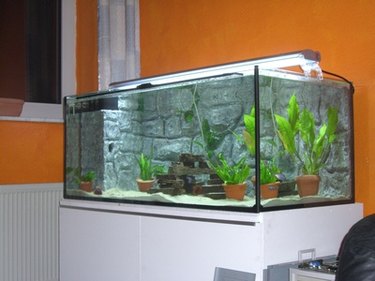Things You'll Need
2 9-volt batteries
2 9-volt battery harnesses
BNC connector
BNC panel
TL082-intergrated circuit chip
pH probe
Digital voltmeter
Soldering iron
Electrical rosin-core solder

A pH meter is usually an electronic device used to measure the acidity of a liquid such as the water in an aquarium. The device consists of a probe connected to a meter that allows the user to get an accurate reading of the pH level in the liquid being tested. Of the various methods to test pH, meters are the most complex as they have to be maintained and calibrated. However, pH meters are much more precise and accurate than other methods. pH meters can be purchased, but it can be more cost-effective to build your own.
Step 1
Attach each 9-volt battery to its own individual battery harness.
Video of the Day
Step 2
Join the negative wire from the first battery harness to Pin 4 on the TL028-integrated circuit chip and solder the connection.
Step 3
Attach the positive wire of the first battery harness and the negative wire from the second battery harness to the BNC rack's grounding latch and solder the triple connection.
Step 4
Connect the positive wire from the second battery harness to Pin 8 on the TL028-integrated circuit chip and use the soldering iron to solder the connection.
Step 5
Attach the BNC connector to the BNC panel. Affix the pH probe to the BNC connector's non-inverting output by screwing it in.
Step 6
Connect the integrated circuit chip to the BNC panel and solder the connection behind the BNC connector.
Step 7
Connect Pin 6 and 7 on the TL028-integrated circuit chip by soldering the two pins together.
Step 8
Attach the voltmeter's positive wire to the soldered connection of Pin 6 and 7 on the chip and use solder to secure the connection.
Step 9
Solder the voltmeter's negative wire to the BNC rack's grounding latch.
Step 10
Calibrate the pH meter by testing pH levels in different solutions. A pH probe will produce approximately 59 millivolts per pH unit. A neutral pH (pH 7) will produce 0 volts. Negative voltages will be produced by acid pHs whereas basic pHs produce positive voltages.
Tip
Calculate pH with the formula: [Millivolts - (voltage at pH 7) = millivolts answer]. Divide the final answer with the formula: [Millivolts answer/ (59 - voltage at pH7 = millivolts per unit)]. Program a calculator to do the arithmetic to make calculating pH simpler or create a graph.
Warning
Always use caution when working with electric and soldering materials. Wear gloves for protection against hazards.
Video of the Day